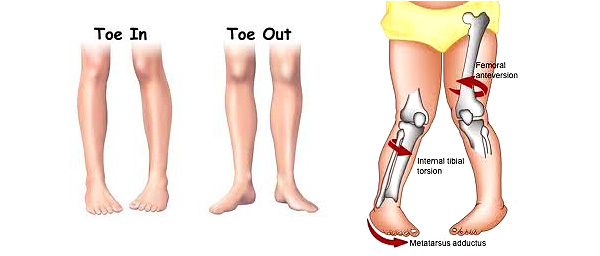In-toeing gait refers to feet turning inward instead of pointing straight ahead when a child walks or runs. It is often referred as “pigeon-toed”. The condition is more common in girls than boys, and it is nearly always symmetrical.
It usually occurs when a child is between 2 and 4 years old (the time period when inward rotation from the hip tends to increase), and is most obvious at age 5 to 6.

In-toeing gait is a common gait abnormality found in children.
There are various degrees of in-toeing. Occasionally, severe in-toeing may cause a young child to stumble or trip on the other heel; sometimes the child may complain of foot pain even with short period of activity.

In-toeing gait conditions: matatarsus vanus (1), internal tibial torsion (2), and medial femoral torsion (3).
There are several causes for an in-toeing gait:
- Excessive inward twist of the thighbone (femoral anteversion).
- Inward position of the hip joint usually due to tight hip ligaments (femoral anteversion).
- Excessive inward twist of leg bone (tibial torsion).
- Curved foot (metatarsus adductus).
- Overpowering or spastic intrinsic muscles of the foot (spastic adductus hallucis muscle).

In-toeing gait can be caused by inward rotation of the hip or the leg.
Treatment
Careful evaluation by a doctor who specializes in alignment of lower extremity can determine the cause of a child’s in-toeing. Each of these conditions may run in families. The doctor may recommend straight last shoes, some simple stretching exercises if the degree of in-toeing is mild, and possibly prescribe a special custom orthotic device call gait plate to support the foot and promote out-toeing gait. In most cases, in-toeing will correct on its own without any casting, special braces, or surgery by 8 to 10 years old. Only the most severe cases need surgery.
If you are concerned about gait or alignment abnormalities seen in your child, contact us or call for a consultation with our doctor.

